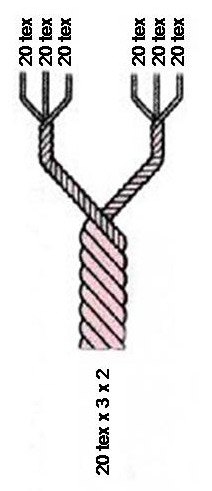|
Ultra Sheer
Ultra sheer refers to very light deniers of stockings or pantyhose, usually 10 or less. The denier of a stocking refers to the thickness of the nylon yarn used in the fabric. The greater the denier, the more durable the material and less prone to tearing (or "getting a run"). Ultra sheer stockings have a very light transparency and a high sheen. References See Also * See-through clothing * Net (textile) Net or netting is any textile in which the yarns are fused, looped or knotted at their intersections, resulting in a fabric with open spaces between the yarns. Net has many uses, and comes in different varieties. Depending on the type of yarn or ... Lingerie Hosiery {{fashion-stub ... [...More Info...] [...Related Items...] OR: [Wikipedia] [Google] [Baidu] |
Denier (measure)
Textile fibers, threads, yarns and fabrics are measured in a multiplicity of units. * A fiber, a single filament of natural material, such as cotton, linen or wool, or artificial material such as nylon, polyester, metal or mineral fiber, or man-made cellulosic fibre like viscose, Modal, Lyocell or other rayon fiber is measured in terms of linear mass density, the weight of a given length of fiber. Various units are used to refer to the measurement of a fiber, such as: the denier and tex (linear mass density of fibers), super S (fineness of wool fiber), worsted count, woolen count, linen count (wet spun) (or Number English (Ne)), cotton count (or Number English (Ne)), Number metric (Nm) and yield (the reciprocal of denier and tex). * A yarn, a spun agglomeration of fibers used for knitting, weaving or sewing, is measured in terms of cotton count and yarn density. * Thread, usually consisting of multiple yarns plied together producing a long, thin strand used in sewing or w ... [...More Info...] [...Related Items...] OR: [Wikipedia] [Google] [Baidu] |
Stocking
Stockings (also known as hose, especially in a historical context) are close-fitting, variously elastic garments covering the leg from the foot up to the knee or possibly part or all of the thigh. Stockings vary in color, design, and transparency. Today, stockings are primarily worn for fashion and aesthetics, usually in association with mid-length or short skirts. History Historically, even though the word ''sock'' is at least as ancient in origin, what men normally wore were often referred to as stockings, probably especially when referring to longer hose. The word ''stock'' used to refer to the bottom "stump" part of the body, and by analogy the word was used to refer to the one-piece covering of the lower trunk and limbs of the 15th century—essentially tights consisting of the ''upper-stocks'' (later to be worn separately as knee breeches) and ''nether-stocks'' (later to be worn separately as ''stockings''). (See Hose.) Before the 1590s, stockings were made of woven cl ... [...More Info...] [...Related Items...] OR: [Wikipedia] [Google] [Baidu] |
Pantyhose
Pantyhose, called sheer tights, or tights, are close-fitting legwear covering the wearer's body from the waist to the toes. Mostly considered to be a garment for women and girls, pantyhose first appeared on store shelves in 1959 for the advertisement of new design panties (Allen Gant's product, 'Panti-Legs') as a convenient alternative to stockings and/or control panties which, in turn, replaced girdles. Like stockings or knee highs, pantyhose are usually made of nylon, or of other fibers blended with nylon. Pantyhose are designed to: * Be attractive in appearance, * Hide physical features such as blemishes, bruises, scars, hair, spider veins, or varicose veins, * Reduce visible panty lines,Glen Raven, Inc.: Turnpage advertisement "How do gals get this sleek bell bottom look without the bumps of garters and panties?'' - ''They don't wear any. They wear Glen Raven Panti-Legs in Cantrece.", USA, 1966 and * Ease chafing between feet and footwear, or between thighs. Besides being ... [...More Info...] [...Related Items...] OR: [Wikipedia] [Google] [Baidu] |
Nylon
Nylon is a generic designation for a family of synthetic polymers composed of polyamides ( repeating units linked by amide links).The polyamides may be aliphatic or semi-aromatic. Nylon is a silk-like thermoplastic, generally made from petroleum, that can be melt-processed into fibers, films, or shapes. Nylon polymers can be mixed with a wide variety of additives to achieve many property variations. Nylon polymers have found significant commercial applications in fabric and fibers (apparel, flooring and rubber reinforcement), in shapes (molded parts for cars, electrical equipment, etc.), and in films (mostly for food packaging). History DuPont and the invention of nylon Researchers at DuPont began developing cellulose based fibers, culminating in the synthetic fiber rayon. DuPont's experience with rayon was an important precursor to its development and marketing of nylon. DuPont's invention of nylon spanned an eleven-year period, ranging from the initial research pr ... [...More Info...] [...Related Items...] OR: [Wikipedia] [Google] [Baidu] |
Yarn
Yarn is a long continuous length of interlocked fibres, used in sewing, crocheting, knitting, weaving, embroidery, ropemaking, and the production of textiles. Thread is a type of yarn intended for sewing by hand or machine. Modern manufactured sewing threads may be finished with wax or other lubricants to withstand the stresses involved in sewing. Embroidery threads are yarns specifically designed for needlework. Yarn can be made of a number of natural or synthetic materials, and comes in a variety of colors and thicknesses (referred to as "weights"). Although yarn may be dyed different colours, most yarns are solid coloured with a uniform hue. Etymology The word yarn comes from Middle English, from the Old English ''gearn'', akin to Old High German ''garn'', "yarn," Dutch "garen," Italian ''chordē'', "string," and Sanskrit ''hira'', "band." History The human production of yarn is known to have existed since the Stone Age and earlier prehistory, with ancient fiber mat ... [...More Info...] [...Related Items...] OR: [Wikipedia] [Google] [Baidu] |
Transparency And Translucency
In the field of optics, transparency (also called pellucidity or diaphaneity) is the physical property of allowing light to pass through the material without appreciable scattering of light. On a macroscopic scale (one in which the dimensions are much larger than the wavelengths of the photons in question), the photons can be said to follow Snell's law. Translucency (also called translucence or translucidity) allows light to pass through, but does not necessarily (again, on the macroscopic scale) follow Snell's law; the photons can be scattered at either of the two interfaces, or internally, where there is a change in index of refraction. In other words, a translucent material is made up of components with different indices of refraction. A transparent material is made up of components with a uniform index of refraction. Transparent materials appear clear, with the overall appearance of one color, or any combination leading up to a brilliant spectrum of every color. The opposit ... [...More Info...] [...Related Items...] OR: [Wikipedia] [Google] [Baidu] |
See-through Clothing
See-through clothing is any garment of clothing made with lace, mesh or sheer fabric that allows the wearer's body or undergarments to be seen through its fabric. See-through fabrics were fashionable in Europe in the eighteenth century. There was a "sheer fashion trend" starting with designer clothing from 2008. See-through or sheer fabric, particularly in skintone (called "nude") colours, is sometimes called illusion, as in 'illusion bodice' (or sleeve) due to giving the impression of exposed flesh, or a revealing ensemble. Mesh, web, or net fabric may have many connected or woven pieces with many closely spaced holes, frequently used for modern sports jerseys. A sheer fabric is a thin cloth which is semi-transparent. These include chiffon, georgette, and gauze. Some are fine- denier knits used in tights, stockings, bodystockings, dancewear and lingerie. It can also be used in tops, pants, skirts, dresses, and gowns. Latex rubber, which is naturally translucent, or plast ... [...More Info...] [...Related Items...] OR: [Wikipedia] [Google] [Baidu] |
Net (textile)
Net or netting is any textile in which the yarns are fused, looped or knotted at their intersections, resulting in a fabric with open spaces between the yarns. Net has many uses, and comes in different varieties. Depending on the type of yarn or filament that is used to make up the textile, its characteristics can vary from durable to not durable. Uses People use net for many different occupations. Netting is one of the key components to fishing in mass quantities. This textile is used because of its sturdy yet flexible origin, which can carry weight yet, still be lightweight and compactable. Fisherman use netting when trawling, because it is sturdy enough to carry large amounts of weight as fish are trapped, pulled, then lifted out of water. Oftentimes, the filaments that make up the yarn are coated with wax or plastic. This coating adds a waterproof component to the textile that provides even more reliability. Net has been used in fashion for centuries. Tulle is a form of net ... [...More Info...] [...Related Items...] OR: [Wikipedia] [Google] [Baidu] |
Lingerie
Lingerie (, , ) is a category of primarily women's clothing including undergarments (mainly brassieres), sleepwear, and lightweight robes. The choice of the word is often motivated by an intention to imply that the garments are alluring, fashionable, or both. In a 2015 US survey, 75% of women and 26% of men reported having worn sexy lingerie in their lifetime. Lingerie is made of lightweight, stretchy, smooth, sheer or decorative fabrics such as silk, satin, Lycra, charmeuse, chiffon, or (especially and traditionally) lace. These fabrics can be made of various natural fibres like silk or cotton or of various synthetic fibres like polyester or nylon. Etymology The word ''lingerie'' is a word taken directly from the French language, meaning undergarments, and used exclusively for more lightweight items of female undergarments. The French word in its original form derives from the French word ''linge'', meaning 'linen' or 'clothes'. Informal usage suggests visually appealing ... [...More Info...] [...Related Items...] OR: [Wikipedia] [Google] [Baidu] |









